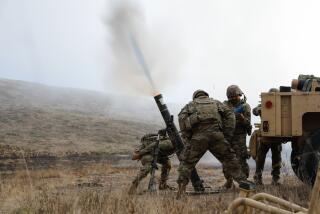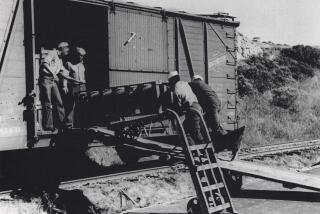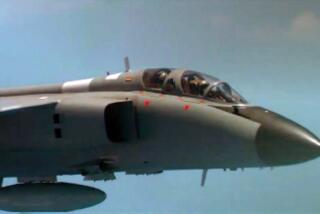Navy Ends Bombing Exercises at Vieques
- Share via
VIEQUES, Puerto Rico — The Navy concluded its exercises on Vieques Island on Wednesday after three days of bombing that sparked protests and ended with scores of activists arrested and four Navy personnel reported injured.
“Ships and aircraft of the USS George Washington Carrier Battle Group successfully completed essential combat training [in Vieques] prior to deploying in the Mediterranean and Arabian Gulf this summer,” the Navy said in a statement.
The move could mean an end for now to the stream of Puerto Rican activists who have been sneaking under a chain-link fence and onto the Navy base on the island. The activists hope to impede the exercises and eventually force the Navy off the island altogether.
But it does not end the controversy over the base. Puerto Rican political leaders met Wednesday with President Clinton.
San Juan Mayor Sila Calderon, leader of the pro-commonwealth Popular Democratic Party, said she was disappointed with the meeting because Clinton refused to discuss the Navy bombing on Vieques.
“Vieques is a much more important issue at this time, and I don’t know if he grasped the magnitude of the explosive situation there is over there,” she said.
Both Calderon and Independence Party leader Ruben Berrios said they asked Clinton to immediately call a referendum for islanders to decide whether they want the Navy to stay or go.
Vieques, a populated Puerto Rican island, is also the site of the Navy’s prime Atlantic Fleet training ground. Exercises on Vieques had stopped in April 1999 after two 500-pound bombs were dropped off target, killing a civilian security guard and sparking protests laced with anti-American sentiment.
But the shelling began again last weekend--this time with inert, or nonexplosive, bombs and shells.
The Navy said 183 people were arrested for trespassing since the exercise began, most of them Puerto Rican Independence Party demonstrators who invaded the bombing range Tuesday, some cutting the chain-link fence, others simply lifting it up to crawl under.
Tuesday brought the first reported violent confrontation in 14 months of agitation: The Navy claimed fishermen lobbed 12-inch metal bars that injured two sailors at sea and that a video recording of the incident was turned over to the FBI. One of the fishermen, Yabureibo Zenon, denied the charge.
The Navy’s Lt. Jeff Gordon said two other Navy personnel also were injured. One had some fingers broken Saturday while detaining a protester inside the range, and another suffered a minor leg injury trying to free a Navy boat from a reef after the incident with the fishermen, he said.
“Go home, Yankees! This is our land!” Elba Diaz, a 43-year-old Vieques housewife, shouted at helicopters overhead that were scanning the area.
As trespassing protesters were rounded up Tuesday, shelling was delayed for 45 minutes, the Navy said. Then fighter jets screamed overhead and thuds and booms could be heard, presumably from an aerial bombardment.
Among the last to be arrested was independence activist Enrique Pesquera, brother of pro-statehood gubernatorial candidate Carlos Pesquera.
Activists committed to ousting the Navy from Vieques say the bombing destroys fishing grounds and endangers residents. The Navy maintains the bombing is safe and provides crucial training.
The first fatality on the range in six decades of bombing united Puerto Ricans as never before to demand that the Navy leave the island. Dozens of protesters invaded the range and occupied it for about a year before being peacefully evicted last month.
The Navy insists the opposition is a tiny minority of Puerto Ricans.
Five months ago, Clinton negotiated an agreement with the Puerto Rican government allowing the Navy to resume training using nonexplosive ordnance. Clinton also promised a referendum, perhaps next year, in which Vieques residents would choose whether to evict the Navy or allow it to stay and resume live bombings.
More to Read
Sign up for Essential California
The most important California stories and recommendations in your inbox every morning.
You may occasionally receive promotional content from the Los Angeles Times.










